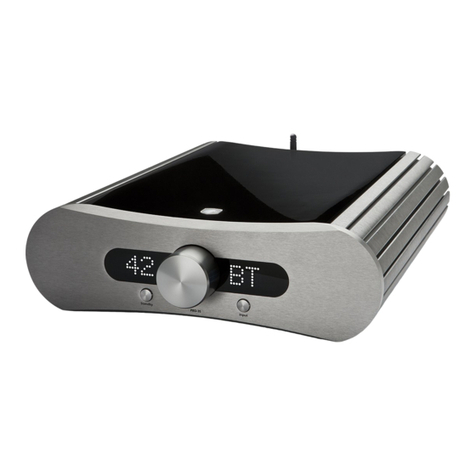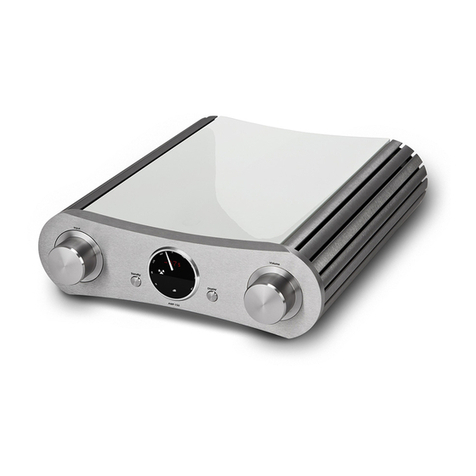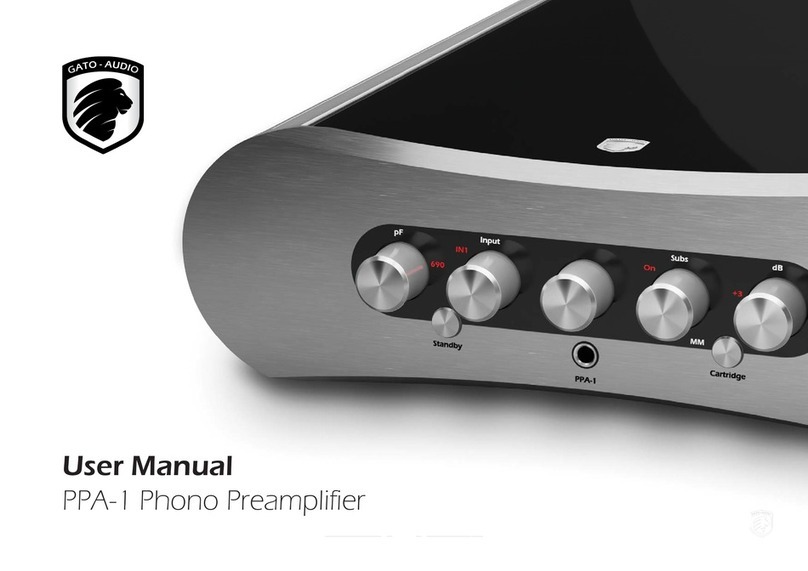User Manual
Page 5
About the amplifier
General design
The main aim for the Gato Audio design team was to create the best sounding integrated amplier possible inside a compact exterior.
Secondly, we wanted to create a line of products where design was not simply a question of a good-looking face plate, but a more
complete product design that looks beautiful from every angle and expresses a classic electro-mechanical look.
The top cover in either real wood veneer or painted nish can be chosen to accommodate other design elements in your home or system.
Preamplier
Mounted on a separate PCB with a separate regulated power supply, the AMP-150’s preamplier is built up of super low-noise, high-
bandwidth analogue amplication and special signal relays originally developed to handle the delicacy of telecom signals. The location
close to the connectors adds several advantages, which include an extremely short signal path as well as remarkably low levels of noise
and distortion interference.
Power amplier
The amplier section features a JFET input stage, a separate power supply for the critical driver circuit and a single set of unique high-
power MOSFET output devices able to handle current levels of more than 150 amperes. This combines loads of power with softness and
the transparent sound of a good tube amplier.
Protection
We have incorporated several advanced and highly eective protection circuits in the output stage in order to protect your amplier and
the connected speakers from abuse and faults. Heat, current and DC are under constant surveillance by a microprocessor, which will shut
down the amplier if the accepted values are exceeded.
Cooling control
The AMP-150 features an advanced active cooling system to provide the most ecient cooling with the lowest noise possible. The system
measures music level and temperature level and processes data individually for each channel. The cooling system activates when music
is playing and will adjust the cooling level accordingly to the temperature level. When music stops the cooling system will lower into
minimum cooling mode and then go into standby when the amplier has been cooled to the idle temperature.
Components
Every single component in the AMP-150 must live up to not only stringent production tolerances and over specied values, but equally
importantly, it will not be selected before having been approved for its sonic capabilities through many intensive listening tests. Simply
put, if it does not sound right inside its circuitry environment, we cannot use it regardless of how good its measurement values are. This
is the only way to maintain a natural, crisp and clear soundstage. Most of the components are only working at 30% of their maximum
workload capacity under normal use. This will ensure your amplier a long life with a minimum of stress.
PCB design
The amplier is divided into three basic parts, each with a separate PCB. The rst is dedicated to the delicate small signals from the source,
input selection and volume control. The second consists of the mains power supply and high-power amplication, and the third is the
microprocessor board that controls the functions and display. All boards are produced from high-quality breglass base with a double-
sided thick copper layer.
Fine-tuning – by listening
The last 5% of ne-tuning and voicing is by far the most complicated and time consuming part of our development work. Single critical
components are replaced, and often voltage and current supplies need to be modied to accommodate them, and consequently, listening
starts all over again.
In addition, blind-test listening is used, not just using our own reference system but also in other setups, as measures we have taken to
complete this amplier just as comprehensively as every other product in our range.





































